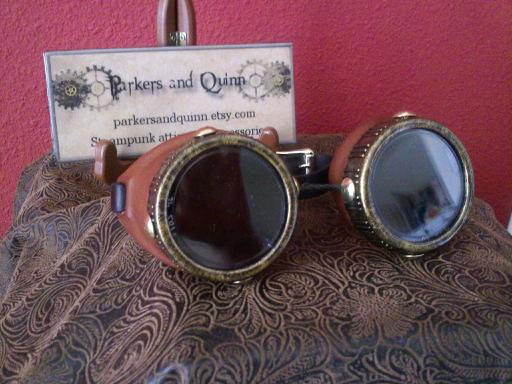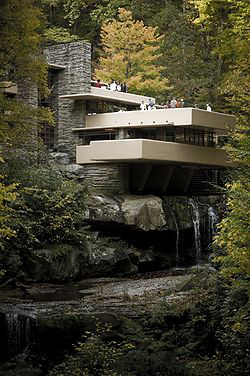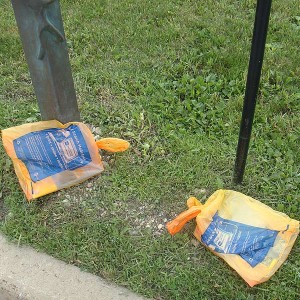
Steampunk Goggles from Parkers and Quinn on Etsy
In recent years, people have started hearing more about steampunk, dieselpunk, cyberpunk, and a whole host of other ‘punks. Steampunk is one of the newer genres of fiction, but it has a surprisingly large following. However, steampunk is not the original ‘punk’ genre. Let’s take a look through the years in ‘punk’.
The parent genre of all of the ‘punk’s is called cyberpunk. During the late 1980’s, the world was becoming a very different place and fiction began to reflect that. As technology grew fantastically quickly, authors extrapolated the trends that they were seeing into the future. All of these extrapolations had a few common themes:
- Dystopic undertones. In the late 80’s, Japan and other Asian countries were on a meteoric rise, in part thanks to a vicious corporate culture. As Japan, Korea, and China got stronger and stronger, the United States started slowing down. Authors began viewing the future as dominated by large corporations, not by nations.
- Dark and gritty settings. Following on from the fact that large corporations would take over, settings became darker. People became interchangeable cogs in the corporate world and the tone was cynical.
- A protagonist who is outside the system. The protagonists in cyberpunk are usually fighting to break down the system or to break the power of a corporation.
- Somewhat advanced technology. Technology is ahead of what we have today, but it’s not so far advanced that we can’t conceive of it happening soon. For example, a staple is a direct link between a brain and a computer.
But steampunk is a little different from cyberpunk. The first and most notable differences are the lack of modern computers and the more positive tone. However, that isn’t to say that computers don’t exist. To the contrary, one of the original stories in steampunk (The Difference Engine) is based on the idea that the Information Age (our age, basically) could have come early through the Difference Engine. (The Difference Engine is a large calculator and is considered the forerunner to the modern computer.) Another is mechanical systems. Because steampunk is based in the Victorian Age (during the reign of Queen Victoria, roughly from 1840 to the turn of the century), steam power is well-developed and very widely used. Three: gadgets. Lots and lots of gadgets, all running on steam power or springs. Four: Modern Values. A key feature of steampunk is that the characters are roughly modern, with modern value systems and beliefs. Effectively, authors of steampunk have taken our time, stripped out all electronics and replaced them with mechanical gadgets.
The steampunk movement has also occurred in real life, not just fiction. There is a decent-size community that modifies household items to steampunk specifications. What do these things look like? Lots of brass, delicate gears, polished wood. In addition, there is a loosely defined steampunk fashion. As long as it fits roughly into the Victorian era, it’s fair play. Military uniforms in particular have a strong influence in steampunk fashion, but there are also anachronistic touches, like aviator goggles or ray guns.

Biopunk at an early stage
But what is dieselpunk? That’s the beauty of the ‘punk’ genres: you can project them over any time period. That said, some time periods will work better than others, but even the Stone Age has a ‘punk genre.
- Prehistoric- Stonepunk (Example: The Flintstones)
- Renaissance- Clockpunk (Leonard Da Vinci, if his sketches had worked)
- Victorian Age- Steampunk (Jules Verne, H.G. Wells)
- Post World War 1- Dieselpunk (1984, Indiana Jones)
- Post World War 2- Atompunk (Visions of the future from the 1950’s, Star Trek)
- Late 1990’s- Cyberpunk* (The Matrix Trilogy, A.I., Minority Report)
- Late 1990’s- Biopunk* (Gattaca, Splice, Frankenstein)
There’s a lot more to the ‘punk’ genre than I’ve been able to cover here. If you’re interested in steampunk, check out H. G. Wells and Jules Verne. If all of this interests you, look up “Retro-Futurism”, which is the study of the past visions of the future (or today). Check it out and enjoy.
*Note that these two genres are set from the same time. Biopunk takes the fears of genetic engineering, while cyberpunk takes the fears of computers and robots. More simply, cyberpunk=machines, biopunk=genes.
Love This? Go Tell it on a Mountain!







